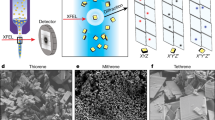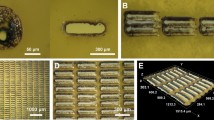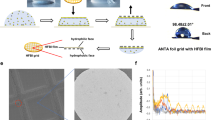Abstract
The new generation of synchrotrons and microfocused beamlines has enabled great progress in X-ray protein crystallography, resulting in new 3D atomic structures for proteins of high interest to the pharmaceutical industry and life sciences. It is, however, often still challenging to produce protein crystals of sufficient size and quality (order, intensity of diffraction, radiation stability). In this protocol, we provide instructions for performing the Langmuir–Blodgett (LB) nanotemplate method, a crystallization approach that can be used for any protein (including membrane proteins). We describe how to produce highly ordered 2D LB protein monolayers at the air–water interface and deposit them on glass slides. LB-film formation can be observed by surface-pressure measurements and Brewster angle microscopy (BAM), although its quality can be characterized by atomic force microscopy (AFM) and nanogravimetry. Such films are then used as a 2D template for triggering 3D protein crystal formation by hanging-drop vapor diffusion. The procedure for forming the 2D template takes a few minutes. Structural information about the protein reorganization in the LB film during the crystallization process on the nano level can be obtained using an in situ submicron GISAXS (grazing-incidence small-angle X-ray scattering) method. MicroGISAXS spectra, measured directly at the interface of the LB films and protein solution in real time, as described in this protocol, can be interpreted in terms of the buildup of layers, islands, or holes. In our experience, the obtained LB crystals take 1–10 d to prepare and they are more ordered and radiation stable as compared with those produced using other crystallization methods.
This is a preview of subscription content, access via your institution
Access options
Access Nature and 54 other Nature Portfolio journals
Get Nature+, our best-value online-access subscription
$29.99 / 30 days
cancel any time
Subscribe to this journal
Receive 12 print issues and online access
$259.00 per year
only $21.58 per issue
Buy this article
- Purchase on Springer Link
- Instant access to full article PDF
Prices may be subject to local taxes which are calculated during checkout











Similar content being viewed by others
References
Saridakis, E. & Chayen, N.E. Towards a 'Universal' nucleant for protein crystallization. Trends Biotechnol. 27, 99–106 (2009).
McPherson, A. & Shlichta, P. Heterogeneous and epitaxial nucleation of protein crystals on mineral surfaces. Science 239, 385–387 (1988).
Caffrey, M. & Cherezov, V. Crystallizing membrane proteins using lipidic mesophases. Nat. Protoc. 4, 706–731 (2009).
Khurshid, S., Saridakis, E., Govada, L. & Chayen, N.E. Porous nucleating agents for protein crystallization. Nat. Protoc. 9, 1621–1633 (2014).
Nicolini, C. et al. Thermal stability of protein secondary structure in Langmuir-Blodgett films. Biochim. Biophys. Acta 1158, 273–278 (1993).
Nicolini, C. Protein monolayer engineering: principles and application to biocatalysis. Trends Biotechnol. 15, 395–401 (1997).
Nicolini, C. et al. P450scc engineering and nanostructuring for cholesterol sensing. Langmuir 17, 3719–3726 (2001).
Bramanti, E. et al. Qualitative and quantitative analysis of the secondary structure of cytochrome C Langmuir-Blodgett films. Biopolymers 42, 227–237 (1997).
Paddeu, S., Ram, M.K. & Nicolini, C. Investigation of ultrathin films of processable poly(o-anisidine) conducting polymer obtained by the Langmuir-Blodgett technique. J. Phys. Chem. B 101, 4759–4766 (1997).
Pechkova, E., Sartore, M., Giacomelli, L. & Nicolini, C. Atomic force microscopy of protein films and crystals. Rev. Sci. Instr. 78, 093704_1–093704_7 (2007).
Facci, P., Erokhin, V. & Nicolini, C. Nanogravimetric gauge for surface density measurements and deposition analysis of LB films. Thin Solid Films 230, 86–89 (1993).
Erokhin, V., Carrara, S., Guerzoni, S., Ghisellini, P. & Nicolini, C. Synchrotron study of heat induced order in protein LB films. Thin Solid Films 327–329, 636–638 (1998).
Erokhin, V., Facci, P. & Nicolini, C. Two-dimensional order and protein thermal stability: high temperature preservation of structure and function. Biosens. Bioelectron. 10, 25–34 (1995).
Pechkova, E., Tripathi, S. & Nicolini, C. MicroGISAXS of Langmuir-Blodgett protein films: effect of temperature on long-range order. J. Synchrotron Radiat. 16, 330–335 (2009).
Maxia, L., Radicchi, G., Pepe, I.M. & Nicolini, C. Characterization of Langmuir-Blodgett films of rhodopsin. Thermal stability studies. Biophys. J. 69, 1440–1446 (1995).
Antolini, F., Paddeu, S. & Nicolini, C. Heat-stable Langmuir-Blodgett film of glutathione-S-transferase. Langmuir 11, 2719–2725 (1995).
Petrigliano, A., Tronin, A. & Nicolini, C. Deposition and enzymatic activity of Langmuir-Blodgett films of alkaline phosphatase. Thin Solid Films 284–285, 752–756 (1996).
Pastorino, L., Berzina, T.S., Troitsky, V.I., Bernasconi, E. & Nicolini, C. Application of monolayer engineering for immobilization of penicillin G acylase. Colloids and Surfaces B: Biointerfaces 23, 289–293 (2002).
Paddeu, S., Fanigliulo, A., Lanzi, M., Dubrovsky, T. & Nicolini, C. LB-based PAB immunosystem: activity of immobilized urease monolayer. Sens. Actuators B Chem. 25, 876–882 (1995).
Pechkova, E. & Nicolini, C. From art to science in protein crystallization by means of thin film technology. Nanotechnology 13, 460–464 (2002).
Pechkova, E. & Nicolini, C. Metodo per la crescita di cristalli di proteine via templati di film sottili proteici omologhi. (Method for protein crystal growth by homologous protein thin film template). Italian Patent ITRM20010405 (A1), filed 9 Jul. 2001, and issued 9 Jan. 2003.
Pechkova, E. & Nicolini, C. Accelerated protein crystal growth onto the protein thin film. J. Cryst. Growth 231, 599–602 (2001).
Pechkova, E. & Nicolini, C. Protein nucleation and crystallization by homologous protein thin film template. J. Cell Biochem. 85, 243–251 (2002).
Pechkova, E. & Nicolini, C. Atomic structure of a CK2alpha human kinase by microfocus diffraction of extrasmall microcrystals grown with nanobiofilm template. J. Cell Biochem. 91, 1010–1020 (2004).
Pechkova, E., Zanotti, G. & Nicolini, C. Three-dimensional atomic structure of a catalytic subunit mutant of human protein kinase CK2. Acta Cryst. D. 59, 2133–2139 (2003).
Pechkova, E., Vasile, F., Spera, R. & Nicolini, C. Crystallization of alpha and beta subunits of IF2 translation initiation factor from archabacteria Sulfolobus solfataricus. J. Cryst. Growth 310, 3767–3770 (2008).
Pechkova, E., Tripathi, S., Spera, R. & Nicolini, C. Groel crystal growth and characterization. Biosystems 94, 223–227 (2008).
Pechkova, E., Scudieri, D., Belmonte, L. & Nicolini, C. Oxygen-bound Hell's Gate globin I by classical versus LB nanotemplate method. J. Cell Biochem. 113, 1820–1832 (2012).
Pechkova, E. & Nicolini, C. Protein nanocrystallography: a new approach to structural proteomics. Trends Biotechnol. 22, 117–122 (2004).
Nicolini, C. & Pechkova, E. Nanocrystallography: an emerging technology for structural proteomics. Exp. Rev. Proteomics 1, 253–256 (2004).
Pechkova, E., Roth, S.V., Burghammer, M., Fontani, D. & Nicolini, C. mGISAXS and protein nanotemplate crystallization: methods and instrumentation. J. Synchrotron Radiat. 12, 713–716 (2005).
Nicolini, C. & Pechkova, E. Structure and growth of ultrasmall protein microcrystals by synchrotron radiation: I. microGISAXS and microdiffraction of P450scc. J. Cell Biochem. 97, 544–552 (2006).
Pechkova, E. & Nicolini, C. Structure and growth of ultrasmall protein microcrystals by synchrotron radiation: II. microGISAX and microscopy of lysozyme. J. Cell Biochem. 97, 553–560 (2006).
Pechkova, E., Gebhardt, R., Riekel, C. & Nicolini, C. In situ GISAXS: I. Experimental setup for submicron study of protein nucleation and growth. Biophys. J. 99, 1256–1261 (2010).
Gebhardt, R., Pechkova, E., Riekel, C. & Nicolini, C. In situ microGISAXS: II. Thaumatin crystal growth kinetic. Biophys. J. 99, 1262–1267 (2010).
Pechkova, E. & Nicolini, C. In situ study of nanotemplate-induced growth of lysozyme microcrystals by submicrometer GISAXS. J. Synchrotron Radiat. 18, 287–292 (2011).
Roth, S.V. et al. Self-assembled gradient nanoparticle-polymer multilayers investigated by an advanced characterization method: microbeam grazing incidence X-ray scattering. Appl. Phys. Lett. 82, 1935–1937 (2003).
Roth, S.V., Autherieth, T. & Mueller-Buschbaum, P. In situ observation of nanoparticle ordering at the air-water-substrate boundary in colloidal solutions using x-ray nanobeams. Appl. Phys. Lett. 91, 091915 (2007).
Muller-Buschbaum, P., Roth, S.V. & Riekel, C. Multiple-scaled polymer surfaces investigated with micro-focus grazing-incidence small-angle x-ray scattering. Europhys. Lett. 61, 639–645 (2003).
Williams, P.A., Cosme, J., Sridnar, V., Johnson, E.F. & McRee, D.F. Mammalian microsomal cytochrome P450 monooxygenase: structural adaptations for membrane binding and functional diversity. Mol. Cell 5, 121–31 (2000).
Tennant, M. & McRee, D.E. The first structure of a microsomal P450--implications for drug discovery. Curr. Opin. Drug Discov. Dev. 4, 671–677 (2001).
Nicolini, C. et al. Prototypes of newly conceived inorganic and biological sensors for health and environmental applications. Sensors 12, 17112–17127 (2012).
Ghisellini, P., Paternolli, C., Chiossone, I. & Nicolini, C. Spin state transitions in Langmuir–Blodgett films of recombinant cytochrome P450scc and adrenodoxin. Colloids Surf. B Biointerfaces 23, 313–318 (2002).
Blodgett, K. & Langmiur, I. Built-up films of barium stearate and their optical properties. Phys. Rev. 51, 964 (1937).
Langmuir, I. & Schaefer, V. Activities of urease and pepsin monolayers. J. Am. Chem. Soc. 60, 1351–1360 (1938).
Blodgett, K. Film built by depositing successive monomolecular layers on a solid surface. J. Am. Chem. Soc. 57, 1007–1022 (1935).
Kuhn, H. Information, electron and energy transfer in surface layers. Pure Appl. Chem. 53, 2105–2122 (1981).
Nicolini, C. Heat-proof enzymes by Langmuir-Blodgett technique. Ann. N. Y. Acad. Sci. USA 799, 297–311 (1996).
Nicolini, C. From neural chip and engineered biomolecules to bioelectronic devices: an overview. Biosens. Bioelectron. 10, 105–127 (1995).
Nicolini, C., Erokhin, V. & Ram, M.K. Supramolecular layer engineering for industrial nanotechnology. in Nano-Surface Chemistry (ed. Rosoff, M.), 141–212 (New York: Marcel Dekker, 2001).
Nicolini, C. Molecular Bioelectronics. Singapore, USA and UK: World Scientific, 1–290 (1996).
Nicolini, C. Engineering of enzyme monolayer for industrial biocatalysis. Ann. N. Y. Acad. Sci. 864, 435–441 (1998).
Nicolini, C. Supramolecular architecture and molecular bioelectronic. Thin Solid Films 284–285, 1–5 (1996).
Nicolini, C. Molecular Bioelectronics – The 19 years of Progress. 2nd edn, 1–315 Singapore, USA and UK: World Scientific, (2016).
Guryev, O. et al. Orientation of cytochrome P450scc in Langmuir-Blodgett monolayers. Langmuir 13, 299–304 (1997).
Paternolli, C., Antonini, M., Ghisellini, P. & Nicolini, C. Recombinant cytochrome P450 immobilization for biosensor applications. Langmuir 20, 11706–11712 (2004).
Facci, P., Erokhin, V., Paddeu, S. & Nicolini, C. Surface pressure induced structural effects in photosynthetic reaction center Langmuir-Blodgett films. Langmuir 14, 193–198 (1998).
Facci, P., Erokhin, V. & Nicolini, C. Scanning tunneling microscopy of a monolayer of reaction centers. Thin Solid Films 243, 403–406 (1994).
Pechkova, E. et al. Thermal stability of lysozyme Langmuir-Schaefer films by FTIR spectroscopy. Langmuir 23, 1147–1151 (2007).
Nicolini, C. & Pechkova, E. Nanostructured biofilms and biocrystals. J. Nanosci. Nanotechnol. 6, 2209–2236 (2006).
Troitsky, V. et al. Deposition of alternating LB monolayers with a new technique. Thin Solid Films 284–285, 122–126 (1996).
Troitsky, V., Sartore, M., Berzina, T., Nardelli, D. & Nicolini, C. Instrument for depositing Langmuir–Blodgett films composed of alternating monolayers using a protective layer of water. Rev. Sci. Instrum. 67, 4216 (1996).
Troitsky, V., Berzina, T.S., Pastorino, L., Bernasconi, L. & Nicolini, C. A new approach to the deposition of nanostructured biocatalytic films. Nanotechnology 14, 597–602 (2003).
Pechkova, E. & Nicolini, C. Proteomics and Nanocrystallography. Springer, 1–190 (2003).
Pechkova, E. & Nicolini, C. From art to science in protein crystallography by means of nanotechnology – one year later. Trends in Nanotechnology Research 31–50 Nova Science Publishers, (2004).
Hann, R.A. Molecular structure and monolayer properties. in Langmuir-Blodgett Films (ed. Roberts, G.G.) 17–92 Springer, (1990).
Nicolini, C., Wright, J. & Pechkova, E. Synchrotron diffraction of multilayered LS PGA film after heating and cooling. NanoWorld J. 1, 4–8 (2015).
Pechkova, E., Fiordoro, S., Barbieri, F. & Nicolini, C. The role of Langmuir-Blodgett (LB) protein thin film in protein crystal growth by LB nanotemplate and robot. J. Nanomed. Nanotechnol, 5, 247 (2014).
Pechkova, E., Tropiano, G., Riekel, C. & Nicolini, C. Radiation stability of protein crystals grown by nanostructured templates: synchrotron microfocus analysis. Spectrochim. Acta B 59, 1687–1693 (2004).
Pechkova, E., Tripathi, S., Ravelli, R.G., McSweeney, S. & Nicolini, C. Radiation stability of proteinase K grown by LB nanotemplate method. J. Struct. Biol. 168, 409–418 (2009).
Pechkova, E., McSweeney, S. & Nicolini, C. Atomic structure and radiation resistance of Langmuir-Blodgett protein crystals. in Synchrotron Radiation and Structural Proteomics Vol 3, (Pan Stanford Series on Nanobiotechnology; eds. Pechkova, E. & Riekel, C.) 249–275 (Singapore: Pan Stanford Publishing, 2011).
Belmonte, L., Pechkova, E., Tripathi, S., Scudieri, D. & Nicolini, C. Langmuir-Blodgett nanotemplate and radiation resistance in protein crystals: state of the art. Crit. Rev. Eukaryot. Gene Exp. 22, 219–232 (2012).
Pechkova, E., Sivozhelezov, V., Tropiano, G., Fiordoro, S. & Nicolini, C. Comparison of lysozyme structures derived from thin-film-based and classical crystals. Acta Cryst. D 61, 803–808 (2005).
Pechkova, E., Vasile, F., Spera, R., Fiordoro, S. & Nicolini, C. Protein nanocrystallography: growth mechanism and atomic structure of crystals induced by nanotemplate. J. Synchrotron Radiat. 12, 772–778 (2005).
Nicolini, C., Belmonte, L., Maksimov, G., Brage, N. & Pechkova, E. In situ monitoring of lysozyme concentration during crystallization in a nanotemplate hanging drop by Raman spectroscopy. J. Microb. Biochem. Technol. 6, 9–16 (2013).
Pechkova, E. et al. Raman spectroscopy of protein crystal nucleation and growth. Am. J. Biochem. Biotechnol. 10, 202–207 (2014).
Pechkova, E. et al. LB crystallization and preliminary X-ray diffraction analysis of L-Asparaginase from Rhodospirillum rubrum. NanoWorld J. 3(S1), S2–S8 (2017).
Wright, J.P., Pechkova, E. & Nicolini, C. Synchrotron powder diffraction study of radiation damage in Langmuir-Blodgett nanotemplate crystallised protein. Am. J. Biochem. Biotechnol. 10, 162–168 (2014).
Pechkova, E., Sivozhelezov, V., Belmonte, L. & Nicolini, C. Unique water distribution of Langmuir-Blodget versus classical crystals. J. Struct. Biol. 180, 57–64 (2012).
Pechkova, E. & Nicolini, C. Domain organization and properties of LB lysozyme crystals down to submicron size. Anticancer Res. 30, 2745–2748 (2010).
Nicolini, C., Riekel, C. & Pechkova, E. Growth and organization of Langmuir-Blodgett protein crystals via in situ GISAXS, laser-microdissection, nanodiffraction, Raman spectroscopy and atomic force microscopy. in Synchrotron Radiation and Structural Proteomics Vol 3 (Pan Stanford Series on Nanobiotechnology; eds. E. Pechkova, C. & Riekel, C.) 383–407 (Singapore: Pan Stanford Publishing, 2012).
Pechkova, E. et al. Laser-microdissection of protein crystals down to submicron dimensions. J. Nanomed. Nanotechnol. S15, 002 (2013).
Nicolini, C., Belmonte, L., Riekel, C., Koenig, C. & Pechkova, E. Langmuir-Blodgett nanotemplate crystallization combined to laser-microfragmentation uniquely characterize proteins crystals by synchrotron microdiffraction. Am. J. Biochem. Biotechnol. 10, 22–30 (2014).
Cusack, S. et al. Small is beautiful: protein micro-crystallography. Nat. Struct. Biol. 5, 634–637 (1998).
Riekel, C. New avenues in x-ray microbeam experiments. Rep. Prog. Phys. 63, 233–262 (2000).
Moukhametzianov, R. et al. Protein crystallography with a micrometre-sized synchrotron-radiation beam. Acta Cryst. D. 64, 158–166 (2008).
Riekel, C., Burghammer, M. & Schertler, G. Protein crystallography micro-diffraction. Curr. Opin. Struct. Biol. 15, 556–562 (2005).
Bozdaganyan, M., Bragazzi, N., Pechkova, E., Shaitan, K. & Nicolini, C. Identification of best protein crystallization methods by molecular dynamics (MD). Crit. Rev. Eukaryot. Gene Exp. 24, 311–324 (2014).
Pechkova, E., Bragazzi, N., Bozdaganyan, M., Belmonte, L. & Nicolini, C. A review of the strategies for obtaining high-quality crystals utilizing nanotechnologies and microgravity. Crit. Rev. Eukaryot. Gene Exp. 24, 325–339 (2014).
Riekel, C., Burghammer, M. & Müller, M. Microbeam small-angle scattering experiments and their combination with microdiffraction. J. Appl. Cryst. 33, 421–423 (2000).
Yoneda, Y. Anomalous surface reflection of X-rays. Phys. Rev. 161, 2010–2013 (1963).
Henke, B.L., Gullikson, E.M. & Davis, J.C. X-ray interactions: photoabsorption, scattering, transmission and reflection at E=50-30000 eV, Z=1-92. At. Data Nucl. Data Tables 54, 181–342 (1993).
Nicolini, C., Bragazzi, N., Pechkova, E. & Lazzari, R. Ab initio semi-quantitative analysis of micro-beam grazing-incidence small-angle X-ray scattering (mGISAXS) during protein crystal nucleation and growth. J. Proteomics Bioinform. 7, 064–070 (2014).
Pechkova, E., Fiordoro, S., Fontani, D. & Nicolini, C. Investigating crystal-growth mechanisms with and without LB template: protein transfer from LB to crystal. Acta Cryst. D. 61, 809–812 (2005).
Vasile, F., Pechkova, E. & Nicolini, C. Atomic structure of the beta-subunit of the translation initiation factor Aif2 from Archaebacteria Sulfolobus solfataricus: high resolution NMR in solution. Proteins 70, 1112–1115 (2008).
Acknowledgements
This work was supported by a FIRB RBPR05JH2P Nanoitalnet grant on Organic and Biological Nanosensors, financed by the Italian Ministry of Education, Universities and Research (MIUR) to C.N. at the University of Genoa (co-principal investigator E.P.); an International FIRB-MIUR RBIN04RXHS grant together with Harvard University on Functional Proteomics and Cell Cycle Progression to C.N. at the University of Genoa (co-principal investigator E.P.); a FIRB RBNE01X3CE grant on Organic Nanotechnologies and Nanosciences financed by MIUR to Fondazione EL.B.A.; (principal investigator E.P.); a PNR-MIUR grant on Biocatalysis to C.N. at the University of Genoa and Fondazione EL.B.A.; and a yearly MIUR Grant for Functioning to Fondazione EL.B.A.; – Nicolini. The authors are grateful to C. Riekel (ESRF) for a long-lasting collaboration in the microGISAXS experiments.
Author information
Authors and Affiliations
Contributions
E.P. and C.N. contributed equally to this work. E.P. performed LB-film depositions and crystallization experiments under the supervision of C.N., E.P. prepared samples for synchrotron X-ray crystallography and microGISAXS. The LB nanotemplate-based flow crystallization cell for in situ microGISAXS experiments was designed by E.P. Both authors collected the data, and C.N. performed microGISAXS data analysis. The manuscript was prepared by E.P., with the discussion of LB method state of the art written by C.N.
Corresponding author
Ethics declarations
Competing interests
The authors declare no competing financial interests.
Supplementary information
Supplementary Methods
Cloning, expression and purification of target-membrane protein cytochrome P450scc. (PDF 135 kb)
Langmuir–Blodgett (LB) nanotemplate deposition procedure.
Protein monolayer transfer is achieved by touching the monolayer with the glass slide in parallel to the air–water interface of the LB trough, followed by horizontal lift according to the Langmuir–Schaefer (LS) technique. The slide can be held by forceps or by a cover slide vacuum gadget (Hampton Research, cat. no. HR8-098). (MOV 2826 kb)
Rights and permissions
About this article
Cite this article
Pechkova, E., Nicolini, C. Langmuir–Blodgett nanotemplates for protein crystallography. Nat Protoc 12, 2570–2589 (2017). https://doi.org/10.1038/nprot.2017.108
Published:
Issue Date:
DOI: https://doi.org/10.1038/nprot.2017.108
Comments
By submitting a comment you agree to abide by our Terms and Community Guidelines. If you find something abusive or that does not comply with our terms or guidelines please flag it as inappropriate.



